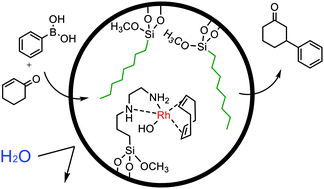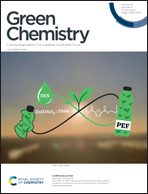Mesoporous silica-supported rhodium complexes alongside organic functional groups for catalysing the 1,4-addition reaction of arylboronic acid in water†
Abstract
The 1,4-addition reaction of arylboronic acid catalysed using a Rh complex is critical in the synthesis of β-arylcarbonyl compounds. However, most organic syntheses are performed in toxic organic solvents that pollute the environment. Conversely, water is cheap, non-toxic, abundant, and green. Therefore, improving the yield of the abovementioned 1,4-addition reaction in water is highly desirable. Here, Rh complexes and organic functional groups were co-immobilized on the internal surface of mesoporous silica with different mesopore diameters. The properties of the mesoporous silica-supported Rh catalysts were characterised using Fourier transform infrared spectroscopy, Rh K-edge X-ray absorption fine structure analysis, inductively coupled plasma atomic emission spectroscopy, CHN elemental and water contact angle analysis, and water vapour adsorption. The mesoporous silica-supported Rh catalyst with a Rh : octyl group ratio of 1 : 15 and a 1.6 nm pore diameter exhibited the highest catalytic activity in water: the yield of the 1,4-addition reaction increased to 93%, whereas a yield of only 31% was observed using the catalyst without the co-immobilized octyl groups. The mesoporous silica-supported Rh catalyst exhibited broad applicability to a range of arylboronic acids and enones.



 Please wait while we load your content...
Please wait while we load your content...
